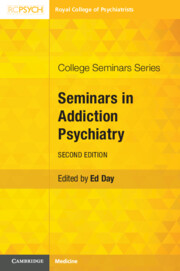50 results
Chapter 14 - Substance Use Disorders
-
-
- Book:
- Seminars in General Adult Psychiatry
- Published online:
- 04 April 2024
- Print publication:
- 18 April 2024, pp 636-653
-
- Chapter
- Export citation
The UK National Recovery Survey: nationally representative survey of people overcoming a drug or alcohol problem
-
- Journal:
- BJPsych Open / Volume 10 / Issue 2 / March 2024
- Published online by Cambridge University Press:
- 14 March 2024, e67
-
- Article
-
- You have access
- Open access
- HTML
- Export citation
Chapter 2 - Illicit Drug Use: Epidemiology, Aetiology and Prevention
-
-
- Book:
- Seminars in Addiction Psychiatry
- Published online:
- 02 November 2021
- Print publication:
- 04 November 2021, pp 15-41
-
- Chapter
- Export citation
Contributors
-
- Book:
- Seminars in Addiction Psychiatry
- Published online:
- 02 November 2021
- Print publication:
- 04 November 2021, pp vi-viii
-
- Chapter
- Export citation
Chapter 1 - Historical and Conceptual Approaches to Addiction
-
-
- Book:
- Seminars in Addiction Psychiatry
- Published online:
- 02 November 2021
- Print publication:
- 04 November 2021, pp 1-14
-
- Chapter
- Export citation
Preface
-
- Book:
- Seminars in Addiction Psychiatry
- Published online:
- 02 November 2021
- Print publication:
- 04 November 2021, pp ix-x
-
- Chapter
- Export citation
Copyright page
-
- Book:
- Seminars in Addiction Psychiatry
- Published online:
- 02 November 2021
- Print publication:
- 04 November 2021, pp iv-iv
-
- Chapter
- Export citation
Chapter 14 - Addiction Problems in a Family and Social Context
-
-
- Book:
- Seminars in Addiction Psychiatry
- Published online:
- 02 November 2021
- Print publication:
- 04 November 2021, pp 252-265
-
- Chapter
- Export citation
Chapter 3 - Illicit Drug Use: Clinical Features and Treatment
-
-
- Book:
- Seminars in Addiction Psychiatry
- Published online:
- 02 November 2021
- Print publication:
- 04 November 2021, pp 42-67
-
- Chapter
- Export citation
Index
-
- Book:
- Seminars in Addiction Psychiatry
- Published online:
- 02 November 2021
- Print publication:
- 04 November 2021, pp 280-300
-
- Chapter
- Export citation
Contents
-
- Book:
- Seminars in Addiction Psychiatry
- Published online:
- 02 November 2021
- Print publication:
- 04 November 2021, pp v-v
-
- Chapter
- Export citation

Seminars in Addiction Psychiatry
-
- Published online:
- 02 November 2021
- Print publication:
- 04 November 2021
Associations between primary care recorded cannabis use and mental ill health in the UK: a population-based retrospective cohort study using UK primary care data
-
- Journal:
- Psychological Medicine / Volume 53 / Issue 5 / April 2023
- Published online by Cambridge University Press:
- 01 October 2021, pp. 2106-2115
-
- Article
-
- You have access
- Open access
- HTML
- Export citation
Chapter 17 - Drug Use Disorders
- from Section 2 - Clinical Issues
-
-
- Book:
- Primary Care Mental Health
- Published online:
- 10 September 2018
- Print publication:
- 20 September 2018, pp 236-250
-
- Chapter
-
- You have access
- HTML
- Export citation
22 - Alcohol
- from Section III - Psychiatric specialties and physical health
-
-
- Book:
- Essentials of Physical Health in Psychiatry
- Published by:
- Royal College of Psychiatrists
- Published online:
- 25 February 2017, pp 301-315
-
- Chapter
- Export citation
23 - Drug misuse
- from Section III - Psychiatric specialties and physical health
-
-
- Book:
- Essentials of Physical Health in Psychiatry
- Published by:
- Royal College of Psychiatrists
- Published online:
- 25 February 2017, pp 316-330
-
- Chapter
- Export citation
Motivational Interviewing: A Guide for Medical Trainees. Edited by Antoine Douaihy, Thomas M. Kelly and Melanie A. Gold. Oxford University Press, 2015, £34.49, pb, 280 pp. ISBN: 9780199958184
-
- Journal:
- BJPsych Bulletin / Volume 41 / Issue 1 / February 2017
- Published online by Cambridge University Press:
- 02 January 2018, p. 62
- Print publication:
- February 2017
-
- Article
-
- You have access
- Open access
- HTML
- Export citation
Chapter 15 - The child with stridor
- from Section 2 - Clinical Conditions
-
-
- Book:
- Managing the Critically Ill Child
- Published online:
- 05 March 2013
- Print publication:
- 07 March 2013, pp 137-145
-
- Chapter
- Export citation
List of contributors
-
-
- Book:
- Managing the Critically Ill Child
- Published online:
- 05 March 2013
- Print publication:
- 07 March 2013, pp vii-x
-
- Chapter
- Export citation
Pharmacy-based intervention in Wernicke's encephalopathy
-
- Journal:
- The Psychiatrist / Volume 34 / Issue 6 / June 2010
- Published online by Cambridge University Press:
- 02 January 2018, pp. 234-238
- Print publication:
- June 2010
-
- Article
-
- You have access
- Open access
- HTML
- Export citation

